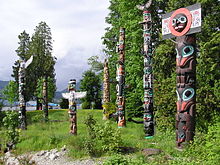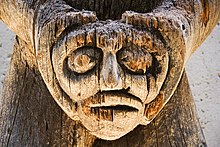Totem pole


A totem pole , more rarely also called heraldic post , is a monumental sculpture that is carved from a large tree trunk and then painted. Totem poles were particularly widespread among the American Northwest Coast Indians . The erection of a totem pole was connected with the alignment of a potlatch , in which the position of the family in the social hierarchy of their respective tribe was confirmed. Contrary to what the first missionaries in British Columbia assumed, totem poles have no religious meaning in the sense of a spiritual totemism . They were neither sacred nor worshiped, but had a social and political function. They are not to be confused with the torture stake used by indigenous peoples in other regions of North America to torture prisoners.
Totem poles are now considered symbols of identity for the indigenous peoples of North America and are in great demand again as works of art. However, as early as the late 19th century, settlers of European descent saw them as a symbol of northwestern North America, as the example of the Seattle totem pole shows. Public institutions in northwest North America are often adorned with contemporary examples of totem poles. One of these is located at Vancouver International Airport , for example .
Totem poles that are in the open seldom get older than 100 years, but rather decay over time. The vast majority of totem poles seen along the Inside Passage coast were erected after 1930. The oldest totem poles shown in museums date from the end of the 18th century. One of the tallest totem poles in the world is in Alert Bay , British Columbia . The brightly colored stake consists of three parts and is 56.4 m high.
Word origin
The term “totem” comes from the word “odoodeman” from an Algonquin language (probably Ojibwa) and means “his clan, his group, his family” or “his family badge”. This means that the terms totem pole and heraldic pole are not in opposition. Only those who interpret the term totem in purely ethnic and religious terms and neglect the context of the term can come to the wrong conclusion that “totem pole” is the wrong name for “coat of arms pole”.
meaning
Totem poles were and are erected for different reasons. They commemorate the deceased, occasionally house the remains of individuals and tell the story of a family or represent the position of a family within the community. Totem poles contain encrypted messages in their representations and are often ambiguous. There are also stakes that mock the owners. This happened when the client failed to pay the stake or broke rules.
Totem poles are usually read from the bottom up. The animal symbolism is usually easy to decipher. The ravens depicted have pointed beaks, while eagles have curved ones. Bears are depicted with flared ears, sharp teeth, and large paws with long claws. Beavers are also often depicted on totem poles. They have strikingly long incisors and tails with cross-hatching. However, the message that these animals symbolize can only "read" who has been informed by the sculptor or the client what a totem pole should represent. If the totem pole was made for two different families, an animal depiction on two different totem poles depicts different beings or tells a different story. If history is forgotten, it can no longer be deciphered. Then only the animal figures can be interpreted, but the connection can no longer be deciphered.
Only family members have the right to tell their specific stories that are manifested in the totem poles. Over the past few years, some families have shared their stories with a wider public, so they have ended up being published in various publications. For example, the totem poles in Saxman, Totem Bight, Ketchikan and Klawock in southeastern Alaska can be interpreted. The three stories of the raven clan, which reproduce the representations of the Seattle totem pole , are also known.
Creation and erection

Totem poles were and are mostly made from the wood of giant arborvitae ( Thuja plicata , Western Red Cedar). A family who wanted to have a totem pole erected would usually hire a carver to do the job. Until well into the 20th century, these were exclusively men. The family instructed the carver exactly what should be depicted on the totem pole. The erection of the totem pole was accompanied by a great festival, a so-called potlatch . At the end of such a potlatch, the host presented his guests with gifts such as blankets, wooden boxes and occasionally cash. By accepting these gifts, the guests confirmed the host's claim to the coats of arms depicted on the totem pole and the social position of the family in the hierarchy of the respective tribe. For this reason, the art historian Aldona Jonaitis emphasizes that the most important function of a totem pole is not its presence in front of the family house, but the alignment of the potlatch that was necessary to erect it.
history
Totem poles were erected before the first Europeans reached the northwest coast of North America in the late 18th century. However, the use of totem poles was limited to the Tsimshian in northern British Columbia and the Haida in Haida Gwaii and southeastern Alaska. Beginning in the early 19th century, the use of totem poles also spread among the Tlingit , later also among the Nuxalk , Kwakwaka'wakw and Nuu-chah-nulth . The spread of totem poles was due to the fact that the increasing availability of iron tools simplified the production of totem poles and the fur trade created a wealth that made it possible to align the potlatch.
From the 1820s, the Hudson's Bay Company established trading posts in the coastal area of British Columbia. The ability to sell furs resulted in the region's indigenous peoples increasingly abandoning their small settlements and moving to larger settlements near these trading posts. The epidemics that broke out among the indigenous peoples as a result of contact with Europeans and led to a massive population decline also contributed to the gathering of tribes that had not previously lived in close proximity to one another. Both of these factors led to the fact that totem poles that were in the old, now abandoned settlements were copied and erected at the new place of residence. The reproduction of ancient totem poles continued throughout the 20th century and was a factor that contributed to the large number of totem poles found in British Columbia today.
The ban on the alignment of potlatches, which was in force in Canada from 1884 to 1951, meant that the number of totem poles erected decreased significantly during this period. The active action of missionaries also contributed to the fact that the erection of totem poles became unusable for several decades. However, some of the indigenous people who converted to Christianity on the northwest coast continued to use the typical bear, raven and sword forest representations on Christian gravestones, among other things.
The totem poles now on display in museums in Canada, the United States, Europe, and Japan are in part historical totem poles dating from the late 19th and early 20th centuries. However, a number of the totem poles shown were also commissioned by museums and erected over the past 40 years. The examples shown also include so-called model totem poles, such as those created by the Haida artist Charles Edenshaw .
supporting documents
literature
- Norman Bancroft-Hunt, Werner Forman : Totem Pole and Mask Dance. The Indians of the Pacific Northwest Coast. Herder, Freiburg (Breisgau) et al. 1980, ISBN 3-451-18829-5 .
- Aldona Jonaitis: Discovering Totem Poles . University of Washington Press, Seattle 2012, ISBN 978-0-295-99187-0 .
- Robin K. Wright: Totem Poles: Heraldic Columns of the Northwest Coast.
- Alfred Hendricks, ed .: Indians of the Northwest Coast. Change and Tradition. First Nations of the Pacific Northwest. Change and Tradition. Westfälisches Museum für Naturkunde , Münster 2005 ISBN 3924590850 (book accompanying a series of exhibitions). Numerous illustrations, bilingual
Web links
Single receipts
- ^ Jonaitis: Discovering Totem Poles. S. XI and XII.
- Jump up ↑ Cathedral Grove: Big Trees & Totem Poles
- ^ Jonaitis: Discovering Totem Poles. S. XII.
- ↑ Totem on etymonline.com
- ↑ a b c Jonaitis: Discovering Totem Poles. S. IX.
- ↑ a b totem pole on indianer-welt.de
- ^ Jonaitis: Discovering Totem Poles. SX
- ^ Coyote - Indian presence. Edition 2004, p. 26 (as PDF; 1.2 MB) accessed on March 14, 2011.
- ↑ a b Jonaitis: Discovering Totem Poles. S. XI.
- ↑ Robin K. Wright: Totem Poles: Heraldic Columns of the Northwest Coast, accessed November 7, 2013
- ^ Jonaitis: Discovering Totem Poles. S. XIII.
- ↑ Historic and newly erected piles and pile systems, e.g. B. on banks in British Columbia; Production of a new stake in Münster for museum purposes, in text and images

